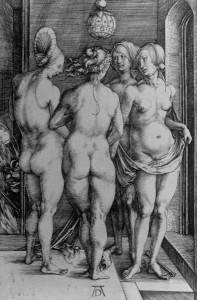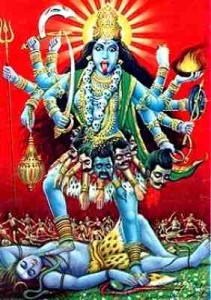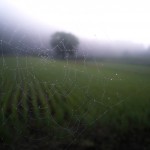Dual observance, the practice of more than one tradition at one time, is more common than most people realize, I think. It’s not just for Pagans, either. For some people, it becomes syncretism, a blending of two (or more) systems into one. For some, one practice is spiritual or religious and the other practice is more cultural. Some people pick and choose parts of various traditions they like, leaving the difficult, challenging, or distasteful aspects by the wayside. For others, like myself, although I have qualities of all the previous forms too, more than one tradition is practiced harmoniously side by side.
Recently I asked a professor of Judaism what her thoughts on Jewish dual observance were, since intermarriage in the wider Jewish community is a hot topic. She told me no one had done any research on this. I think dual observance would make a great academic paper for a graduate class, conference panel, or research seminar. This post is not that paper. Most of my thoughts here are from my own experience, as well from what’s in my head after my own graduate work.
We can find many examples of syncretism and dual-observance throughout history. Would these people from the past see themselves as dually observant? It’s hard to say, as the concept wasn’t well developed, and the practice was usually discouraged by authorities. For example, take the tradition of cunning folk in England and Wales. These people performed tasks that we today might identify as witchcraft. Yet, most cunning folk considered themselves Christians. They used bits of Psalms or holy water to perform their spells. They just happened to have gifts or skills that others didn’t, and they would use them in the service of their communities (however defined).

Looking at medieval Europe, we also see people who fit the modern day description of the village witch. Did they see themselves as witches? Likely not. Many of these people also attended church and participated in their community’s Christian folk traditions. Using specialized skills and working with spirits may not have been viewed as ‘other’ or outside of church tradition, but rather as one more tool to aid themselves and their community.
What I have found in my own present day experience is that dual observance makes many people uncomfortable. It’s much easier for people if a person is One or the Other. I see this in people’s confusion around sexual identities (bisexual? polysexual? what?), racial identities (being bi-racial or mixed race confuses the heck out of white folk), and myriad other expressions of self, chosen or otherwise. But this seems to stem from a hegemonic view point, one that thinks we all need to be Just One Thing. I see a lot of Christian thinking here. Christianity is exclusivist, claiming to be the One Right Way. Many (but not all) Christians believe that there is only one, or at most very few, ways to be an ‘authentic’ Christian. I have heard more than one Protestant tell me that Catholics aren’t really Christians.
This exclusivist strain of Christianity makes a little bit of sense when viewing that tradition by its own standards. I see where they are coming from. In all the years I was earnestly trying to be a Christian, I never got baptized. I really wanted to join the Eastern Orthodox Church, but felt that I needed to be more fully on-board with their beliefs in order to join. Several ‘cradle’ Orthodox (those born into the tradition) told me that I was over-thinking things, that Orthodoxy needed more voices, that no one was perfect or believed completely in every detail. Maybe if I had been born into Orthodoxy or into the Christian tradition, period, I would have felt that it was more mine to alter. As it was, I felt like a guest. I would never come into your home and ask you to redecorate; why would I join a tradition I wanted to change?
When I began my blog project two and half years ago (exploring traditions that I had been practicing in one form or another already), it was an experiment in living as if: as if I was a Pagan, as if I was a Hindu, as if I was a Christian (again). My ‘faith’ has come from my experiences in the doing. At the end of the experiment I realized that the gods had shown up for me during my Hindu quarter and Feri* quarter. I experienced much depth of these spirits during my focus on Place. Christianity was a dead end for me.
Both Feri and the Tantric Hinduism I pursue have many similarities. The deeper I go in my own practice the more I see where the Current gleams in other traditions too. We do not need to have all the same practices, beliefs or gods for me to feel a common heartbeat. However, I find that rarely do my practices conflict. They support one another in ways that often astonish me. I am a stronger Feri practitioner because of my Hindu devotions, and a better Hindu devotee because of the strength of my Feri work.
You may notice that I rarely call myself a Feri or a Hindu. That’s for several reasons. I am not initiated into either tradition. I do not have a guru for my Tantra practice. I call myself a practitioner or a devotee. I often tell people, when asked, “I practice a form of American Traditional Witchcraft and have a Hindu devotion.” I am most reluctant to label myself as a Hindu. I am not of any ethnic or cultural heritage from which Hinduism springs. I have not adopted most forms of South Asian expressions of Hinduism, which is what most Americans (and many Hindus, frankly) look for. Most importantly, I have no Hindu community near me. Yes, I go to yoga class occasionally. There is one in my town that actually focuses more on the Hindu aspects of yoga, which I love. But it’s not the same as a community of people worshiping together. Whereas with Feri I have teachers and a thriving (mostly online) community of friends who are initiates or students.

My dual observance feels juicy and fruitful at this point in my life. It feeds me spiritually and enriches my family life. I finally, after all my years of longing and searching, decided to trust myself, my Self. That trust has led me here. I will continue to deepen both of my practices, my observances, my chosen traditions, until my Self says otherwise.
*A note on spelling. A few years ago there was a split in the Feri/Faery tradition. One side chose one spelling and the other another spelling. I have not written about this split, nor publicly declared sides, as it is not useful nor necessary for me to do so at this time. No one has asked me to, and as an non-initiate I don’t think my opinion is useful, at this time. However, I do have opinions. They are not necessarily represented in my choice of spelling. I choose to spell my practice with the FERI spelling for three reasons: one, I think it’s neat; two, most people are familiar with Feri via this spelling; and three, it’s more immediately distinct from other forms of faery/faerie/fairy/etc out there.
Sources and Resources
Yvonne Arburrow’s four-part series on Dual-faith practices. This blog series at Patheos is scholarly, sociological, and a great intro to what dual observance is all about. It also has an extensive bibliography.
Carlo Ginzberg, The Night Battles. A scholarly text subtitled “Witchcraft and Agrarian Cults in the Sixteenth and Seventeenth Centuries.” It focuses on communities in Italy. More interesting that you might think!
Michael Howard, Welsh Witches and Wizards. He talks about cunning folk in Wales here. You can also read my short review of the book.
Two great blog posts on dual-observance: Downstrodden’s experience and a great post from the always fantastic Nicholaj de Mattos Frisvold.















